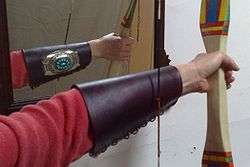
Bracer
Encyclopedia

Leather
Leather is a durable and flexible material created via the tanning of putrescible animal rawhide and skin, primarily cattlehide. It can be produced through different manufacturing processes, ranging from cottage industry to heavy industry.-Forms:...
, stone
Rock (geology)
In geology, rock or stone is a naturally occurring solid aggregate of minerals and/or mineraloids.The Earth's outer solid layer, the lithosphere, is made of rock. In general rocks are of three types, namely, igneous, sedimentary, and metamorphic...
, or plastic
Plastic
A plastic material is any of a wide range of synthetic or semi-synthetic organic solids used in the manufacture of industrial products. Plastics are typically polymers of high molecular mass, and may contain other substances to improve performance and/or reduce production costs...
that covers the inside of an archer's
Archery
Archery is the art, practice, or skill of propelling arrows with the use of a bow, from Latin arcus. Archery has historically been used for hunting and combat; in modern times, however, its main use is that of a recreational activity...
arm to protect it while shooting. Bracers keep the inside of the archer's forearm from getting hurt by the string
Bow string
A bow string joins the two ends of the bow stave and launches the arrow. Desirable properties include light weight, strength, resistance to abrasion, and resistance to water...
of the bow
Bow (weapon)
The bow and arrow is a projectile weapon system that predates recorded history and is common to most cultures.-Description:A bow is a flexible arc that shoots aerodynamic projectiles by means of elastic energy. Essentially, the bow is a form of spring powered by a string or cord...
or the fletching of the arrow
Arrow
An arrow is a shafted projectile that is shot with a bow. It predates recorded history and is common to most cultures.An arrow usually consists of a shaft with an arrowhead attached to the front end, with fletchings and a nock at the other.- History:...
; they also prevent loose clothing from catching the bow string. They normally cover part of the forearm only, but chest-guards are sometimes worn, usually by female archers, and other areas have at times been protected. With some combinations of non-baggy clothing and bows with a larger distance between the bow and the string, the archer may not need to wear any bracer.
Decorated bracers
The modern Navajo peopleNavajo people
The Navajo of the Southwestern United States are the largest single federally recognized tribe of the United States of America. The Navajo Nation has 300,048 enrolled tribal members. The Navajo Nation constitutes an independent governmental body which manages the Navajo Indian reservation in the...
and Hopi
Hopi
The Hopi are a federally recognized tribe of indigenous Native American people, who primarily live on the Hopi Reservation in northeastern Arizona. The Hopi area according to the 2000 census has a population of 6,946 people. Their Hopi language is one of the 30 of the Uto-Aztecan language...
have developed bracers known as "ketoh", which are decorated with silver, turquoise, and other adornments, possibly from earlier examples made of bone. Ketohs usually have a central motif, sometimes with a stone ornament, and four curvilinear shapes that radiate toward the corners. Ketohs may have a smooth leather surface on the inside of the arm and are functional, but they are normally used as items of personal and ritual adornment, or as works of art
Work of art
A work of art, artwork, art piece, or art object is an aesthetic item or artistic creation.The term "a work of art" can apply to:*an example of fine art, such as a painting or sculpture*a fine work of architecture or landscape design...
in their own right.
Stone wrist-guard
Stone wrist-guard
Early Bronze Age stone wrist-guards are found across Europe from around 2400-1900BC and are closely associated with the Beaker culture and Unetice culture...
s from Beaker culture
Beaker culture
The Bell-Beaker culture , ca. 2400 – 1800 BC, is the term for a widely scattered cultural phenomenon of prehistoric western Europe starting in the late Neolithic or Chalcolithic running into the early Bronze Age...
graves of the European Bronze Age have been thought to be archery bracers. However, they are usually found on the outside of the arm where they would have been more conspicuous. Many have only two holes which would make them difficult to fasten securely to the arm, and some have projecting rivets which would catch on the bow string and make them unsuitable for use as a bracer. Many show great skill in polishing and stone working, and few are found in areas from which their stone originates. When the objects occur in barrows, they always occur in the central primary grave, a place thought to be reserved for heads of family and other important people. They may have been status symbols of prowess in hunting or war, probably mounted as decorations on functional bracers. A few prehistoric wrist-guards made of gold or amber have also been found; scholars believe these were for ornamental rather than functional use.
External links
- Archer's Gear: The bracer, La Belle Compagnie Website

